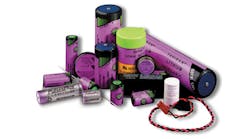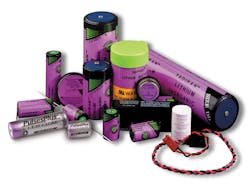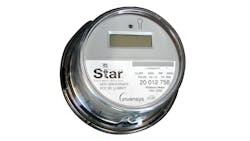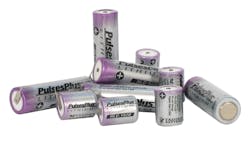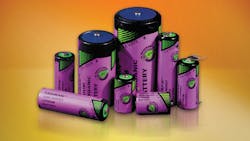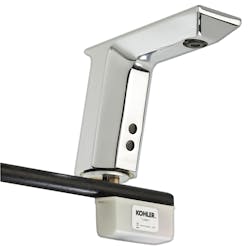Short-range wireless sensors are experiencing rapid growth in wide range of applications: RFID to GPS tracking, traditional automatic meter reading (AMR) plus advanced metering infrastructure (AMI), mesh networks, system control and data acquisition (SCADA), data loggers, measurement while drilling, oceanography, environmental systems, emergency/safety systems, military/aerospace systems, and more. Many of these applications rely on long-life lithium batteries with a potential lifespan of up to 40 years, especially in remote locations where battery replacement is difficult or impossible.
However, actual battery life is often difficult to prove because it’s not particularly easy to test primary lithium batteries for lifespan in conditions that accurately simulate in-field use. Therefore, design engineers must be extremely diligent in demanding verifiable information from battery manufacturers to avoid unscheduled battery replacements, which can incur 10 times the initial cost of the original battery (see “Specifying A Primary Lithium Battery”).
LiSOCl2 Enables 40-Year Service
Bobbin-type lithium-thionyl-chloride (LiSOCl2) chemistry is overwhelmingly preferred forremote wireless sensors because it offers the highest specific energy (energy per unit weight) and energy density (energy per unit volume) of all current battery chemistries (Fig. 1). Lithium delivers high energy density due to its large electric potential, which exceeds other metals. It produces the higher 2.7- to 3.9-V dc voltages typical of lithium batteries.
1. Bobbin-type lithium-thionyl-chloride (LiSOCL2) chemistry is preferred for remote wireless sensors because of its high specific energy, high energy density, wide temperature range, and very low annual self-discharge rate.
Lithium cells use a non-aqueous electrolyte, enabling certain LiSOCl2 batteries to operate in extreme temperatures typically ranging from –55°C to 125°C. Certain cells are adaptable to the cold chain, down to –80°C. For example, Tadiran tested LiSOCl2 cells in a cryogenic chamber and subjected them to progressively lower temperatures down to –100°C. These LiSOCl2 cells continued to operate as necessary.
LiSOCl2 chemistry is also renowned for long life. Formerly known as Hexagram, Aclara began using bobbin-type LiSOCl2 batteries in 1984 to power meter transmitter units (MTUs) for automated meter reading systems used by water and gas utilities (Fig. 2). These older devices are now being replaced by more technically advanced equipment, but the original batteries are still operating after 28 years in the field. This real-life example gives AMR/AMI equipment manufacturers the confidence to offer long-term performance contracts that increase the total return on investment (ROI) of an AMR/AMI network.
2. LiSOCL2 batteries have been utilized for decades in AMR applications, with some systems still operating on their original batteries after 28 years.
Not All Lithium Batteries Are Created Equal
While many battery manufacturers claim low annual self-discharge rates at ambient temperatures, such claims may be invalid depending on the construction method or specific design requirements. For example, testing on Tadiran batteries shows that these cells have an average self-discharge of approximately 0.7% per year, while other batteries using the same chemistry have 2.5% to 3% annual self-discharge.
The use of inferior raw materials or non-standard manufacturing techniques can lead to uneven battery performance. This includes batch-to-batch inconsistencies that raise the risk of anomalies in the field, even if initial performance characteristics seem identical. As a result, advanced manufacturing processes based on Six Sigma and statistical process control (SPC) methodologies are required to ensure consistent product quality.
When it comes to selecting the ideal battery, each application is unique in terms of a set of application-specific parameters:
- Overall energy consumption during sleep mode
- Energy consumption during active mode entailing the size, duration, and frequency of high current pulses, where applicable
- Battery self-discharge rate, which is sometimes higher than the actual sensor average-use rate
- Equipment cutoff voltage
- Length of storage periods
- Thermal environments
Experienced battery manufacturers know how to create a customer-specific energy-use profile along with sensitivity analyses. The end result is a mathematical model that accurately predicts battery-life expectancy.
Two-Way Requirements
Wireless sensors are increasingly providing “on demand” two-way RF communications, with the device operating in two modes. One is a dormant or sleep state where daily power consumption ranges from nil to a few microamps. The other is an active interrogation and transmission mode requiring high current pulses up to hundreds of milliamps for short-range RF communications to a few amps for certain GPRS protocols.
If a wireless sensor remains dormant for extended periods at elevated temperatures and is occasionally interrupted by a high current pulse, lower transient voltage could result during initial battery discharge, especially in low temperatures. This phenomenon, known as transient minimum voltage (TMV), is strongly related to the quality of battery electrolyte or cathode.
One alternative is to combine supercapacitors with lithium cells, a solution that tends to fail prematurely due to relatively high self-discharge. A supercapacitor comprising dual 2.5-V capacitors also needs a balancing circuit to ensure acceptable service life. And, supercapacitors have a limited temperature range, disqualifying them for use in some applications.
To address the needs of advanced two-way communications, combine a standard bobbin-type LiSOCl2 battery that works in parallel with a hybrid layer capacitor (HLC). Tadiran’s PulsesPlus LiSOCl2 battery supplies long-term, low-current power while the patented HLC delivers high current pulses up to 15 A to eliminate the voltage delay that normally occurs when a pulsed load is initially drawn (Fig. 3). It allows users to program their devices to communicate low-battery status alerts. A 3.6-V system indicates when battery capacity is approximately 95% exhausted, while a 3.9-V system indicates when 90% capacity is gone.
3. PulsesPlus batteries utilize a patented hybrid layer capacitor (HLC) to deliver the high current pulses required for advanced two-way communications.
The HLC is a single unit that works in the 3.6-V to 3.9-V nominal range to avoid the balancing and current leakage problems associated with supercapacitors. It has been field proven to deliver high current pulses and a high safety margin.
Tadiran’s TRR series LiSOCl2 batteries are designed for moderate current pulse applications (Fig. 4). These batteries don’t require an HLC. Or, they can use a smaller HLC to deliver high capacity and high energy density without voltage or power delay. They virtually eliminate the voltage drop associated with a standard LiSOCl2 battery when it faces an initial load, especially at cold temperatures or when the battery is nearing the end of its operating life.
4. Tadiran TRR series batteries don’t need an HLC but can deliver moderate current pulses without voltage or power delay.
Design History
The Kohler Hybrid energy system is the first battery-powered, no-maintenance, water-saving solution designed to last 30 years (Fig. 5). This commercial faucet uses Kohler Insight Technology to continuously analyze and log feedback from its environment, automatically recalibrating the factory default settings to eliminate false actuations caused by low lighting or highly reflective lighting, two challenging conditions that commonly plague battery-powered systems.
5. Kohler commercial faucets utilize a hybrid energy system powered by LiSOCL2 batteries with HLCs to operate maintenance-free for 30 years.
To maintain a 30-year life, the system employs a LiSOCl2 battery with a patented hybrid layer capacitor. When the faucet opens, the capacitor collects and discharges small electrical charges. Additionally, the faucet is mercury-free, with no harmful chemicals or additives.
Powercast Corp. uses hybrid lithium batteries to power its WSN-1101 wall-mounted sensor, which measures indoor temperature and humidity (Fig. 6). The WSN-1101 finds employment in HVAC, lighting control, energy management, industrial monitoring, and medical applications.
6. Powercast WSN-1101 battery-powered wireless sensors instantly convert buildings into smart buildings with remote monitoring of HVAC, lighting, and other building automation systems.
Designed for indoor use in temperatures ranging from –20°C to 50°C, the sensor can transmit data once per minute for more than 25 years to the Powercast WSG-101 wireless gateway, which interfaces with wired building automation systems (BAS) networks via industry-standard protocols.
The use of a long-life LiSOCl2 battery enables Powercast to offer a highly cost-effective and reliable 25-year system that instantly converts buildings into smart buildings. It proves to be an ideal upgrade for older structures with concrete or cinder block walls that cannot be easily retrofit for hard-wired solutions.
Sol Jacobs is the vice president and general manager of Tadiran Batteries. He has more than 25 years of experience in developing solutions for powering remote devices. He holds a BS in engineering and an MBA.
